Abstract
The perioral region is central to facial aesthetics and nonverbal communication but is particularly prone to age-related changes, including volume loss, dermal thinning, and the development of static wrinkles. Because these changes are multifactorial, treatments that address both structural and textural alterations may achieve better outcomes than monotherapy. This study evaluated the novel Nlines protocol, which combines PEGDE-crosslinked hyaluronic acid filler with non-ablative fractional 1470 nm diode laser treatment to improve skin quality in the lower facial third. Two female patients with Fitzpatrick skin types III and II, underwent either the standard Nlines protocol or the enhanced Nlines+ version, which included additional collagen-stimulating filler sessions.
Both completed 2–3 treatment sessions at 1–2-month intervals, targeting the marionette lines, nasolabial folds and accordion lines. No complications occurred, with only mild, transient erythema reported. Patients described an immediate “glow effect” after treatment, followed by progressive improvements over several weeks, including reduced wrinkles, refined pores, enhanced texture, and increased firmness. These results were consistent across different ages and baseline severities. The findings suggest that the Nlines protocol is a safe, well-tolerated, and effective approach for perioral rejuvenation, offering both immediate and long-lasting improvements in skin quality.
Keywords:Nlines Protocol; Hyaluronic Acid (HA); Non-Ablativ Laser; Pegde; Static Fine Lines
Abbreviations: HA: Hyaluronic acid; PEG: Polyethylene glycol; PEGDE: Polyethylene glycol diglycidyl ether; PEGDE-HA: Polyethylene glycol diglycidyl ether–crosslinked hyaluronic acid; CaHA: Calcium hydroxyapatite; FDA: Food and Drug Administration; GAIS: Global Aesthetic Improvement Scale; FACE-Q: (standardized patient-reported outcome measure for facial aesthetics)
Introduction
Facial attractiveness and perceived age are strongly influenced by balanced facial proportions and the condition of the skin, particularly in expressive regions that naturally draw attention during social interactions such as smiling or speaking [1-3]. Youthful skin radiance, symmetry, and harmony among facial features serve as markers of health and attractiveness, cues consistently observed even in infants’ preferences [2,4]. Within the lower facial third, the perioral region plays a central role in nonverbal communication [5,6]. Aging introduces a range of structural and physiological changes in the perioral zone. These include volume reduction in fat compartments, dermal thinning, loss of elasticity, formation of bar-code perioral wrinkles, marionette lines, lip elongation, diminished upper-teeth display, and uneven pigmentation-changes driven by intrinsic aging processes, photodamage, smoking, and repetitive muscle activity [5].
Recent advancements in perioral rejuvenation protocols have introduced innovative approaches. Laser-based methods like Endolift that increase dermal density and reduce nasolabial and marionette lines without the need for general anesthesia [7], as well as autologous fat grafting techniques aimed at replenishing lost volume and enhancing skin quality-albeit with challenges in graft survival and potential complications [8]. However, given the multifactorial nature of perioral aging, monotherapy is often insufficient. Combining hyaluronic acid (HA) fillers to restore volume with laser treatments that enhance skin quality and texture creates a more balanced, natural, and lasting improvement [9-11]. Several treatment protocols now integrate these complementary approaches into a single plan to address volume loss, skin aging, and anatomical asymmetries for optimal rejuvenation [11].
Hyaluronic acid fillers remain the gold standard in aesthetic medicine due to their safety, effectiveness, and biocompatibility. Naturally found in skin and connective tissues, HA is chemically cross-linked to extend its longevity and improve performance [12]. Cross-linking agents like BDDE have long been used to enhance filler longevity, but newer polyethylene glycol (PEG)-based cross-linking offers improved safety and reduced immunogenicity [9,13]. PEG also provides better thermal tolerance, which allows safe combination with laser treatments [14,15]. PEGylated fillers exhibit enhanced cohesivity, superior viscoelasticity, and improved tissue integration [16]. In the last two decades, advances in laser technology, particularly fractional resurfacing, have transformed rejuvenation. By creating microscopic thermal zones while sparing surrounding skin, fractional lasers stimulate healing and collagen production [17].
Non-ablative systems offer effective results with minimal downtime and greater safety for darker skin types [18]. Today, the most effective results often come from protocols that combine fillers, lasers, and other complementary treatments to address the full range of age-related changes. In this study, we describe a protocol developed by the authors, termed „Nlines”, which integrates two treatments: a polyethylene glycol diglycidyl ether (PEGDE) crosslinked hyaluronic acid (HA) hydrogel (Neauvia Intense Rheology, Matex Lab, Switzerland) and a 1470 nm diode laser (LaserME, Berger&Kraft Medical Sp. z o.o., Poland). This innovative, minimally invasive approach is suitable for all skin types and aims to improve static fine lines, strengthen the dermis, and stimulate collagen production.
Materials and Methods
We present two female patients, aged 46 and 49, with Fitzpatrick skin phototype III and II, and a confirmed clinical diagnosis of skin elastosis with static wrinkles in the treatment area (Figure 1). Treatments were administered between January 2024 and April 2024, and between November 2023 and December 2023. Prior to the initial session, both patients provided written informed consent, including permission for the use of photographic images for analysis. All procedures were conducted in accordance with the established treatment protocol and the specific clinical indications.
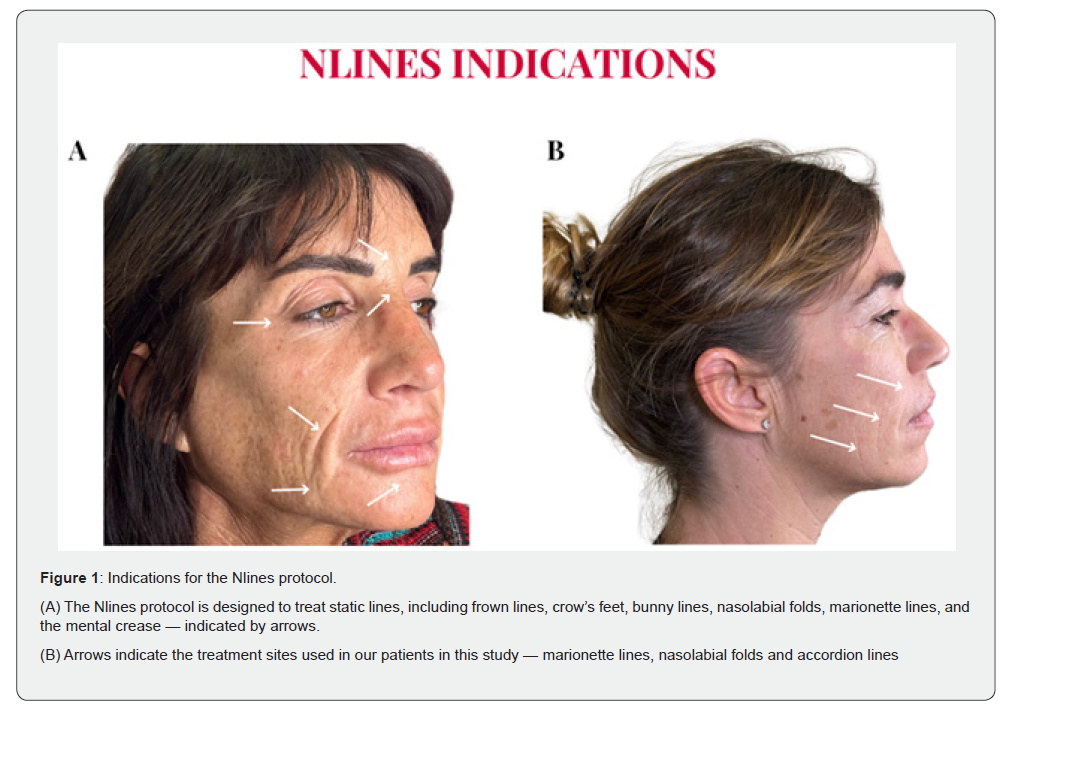
Treatment Protocol
Both patients underwent 2–3 treatment sessions scheduled at intervals of 1–2 months. The primary treatment areas were the marionette lines, nasolabial folds and accordion lines. On Day 0, a fern-pattern injection technique was performed using Intense Rheology - a cross-linked hyaluronic acid (PEGDE-HA) filler (22 mg/mL) combined with glycine and L-proline (Neauvia Intense Rheology, Matex Lab, Switzerland). Multiple intradermal microinjections (1–2 mm depth) of small HA volumes were administered with a 30G × 13 mm needle and a prefilled 1 mL syringe (Figure 2). The average filler volume per site was variable; for example, in nasolabial folds, as little as 0.1–0.2 mL was often sufficient.
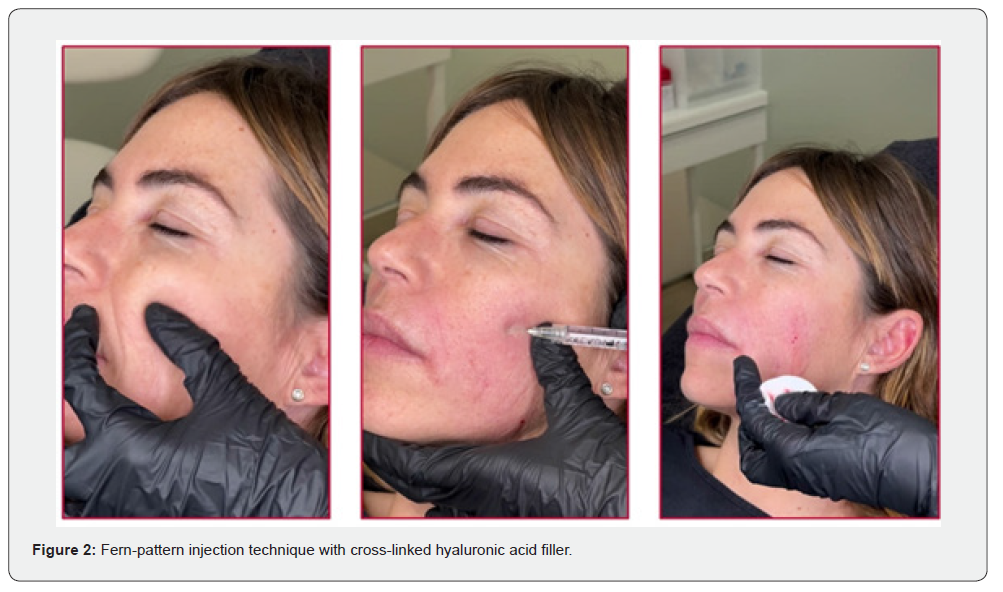
Topical anesthesia was available but not required by either patient. In patient no. 2, the protocol was enhanced using the NLINES+ approach with Stimulate. Following the standard Nlines procedure with the fern-pattern technique, 1–2 mL of Stimulate - a cross-linked PEGDE-HA filler (26 mg/mL) containing 1% CaHA, glycine, and L-proline (Neauvia Stimulate, Matex Lab, Switzerland) - was administered with a cannula into the subdermal plane. This strategy not only restored volume in areas of mild atrophy but also acted as a collagen stimulator, complementing the lifting effect of the Nlines technique.
Although not used in this case, Hydro Deluxe-a non-crosslinked HA filler (18 mg/mL) combined with 0.01% calcium hydroxyapatite, glycine, and L-proline (Neauvia Hydro Deluxe, Matex Lab, Switzerland)-may be incorporated into the Nlines+ protocol as superficial papules to enhance hydration and skin texture, with any remaining product used to improve overall dermal quality. Due to its superficial placement, complete absorption may require additional time. The choice of variants depends on clinical presentation: Stimulate for static wrinkles with volume loss, Hydro Deluxe for poor skin quality, or a combination of both in complex cases. This flexibility allows precise tailoring of the Nlines+ protocol to maximize functional and aesthetic outcomes.
Both patients adhered to a post-treatment care protocol consisting of sun avoidance, daily use of a broad-spectrum sunscreen, avoidance of acids and retinoids for one week, and application of a restorative moisturizer (such as a ceramide shield) to support skin barrier recovery. Follow-up assessments were performed at 4 weeks, coinciding with the next treatment session.
Results
This case study included two participants, aged 46 and 49, with Fitzpatrick skin types III and II Patient 1 underwent the full Nlines protocol across two treatment sessions. Patient 2 received the Nlines+ protocol, which included additional two sessions of Neauvia Stimulate injections alongside three sessions of the standard Nlines protocol. Detailed treatment regimens for each patient are provided in Table 1. Both patients completed all scheduled sessions. Comparison of baseline and post-treatment photographs demonstrated significant improvements in skin tone and overall skin quality. Notable visible changes in the facial area included reduced wrinkles, refined pores, enhanced skin texture, and increased firmness (Figure 3, 4, 5).
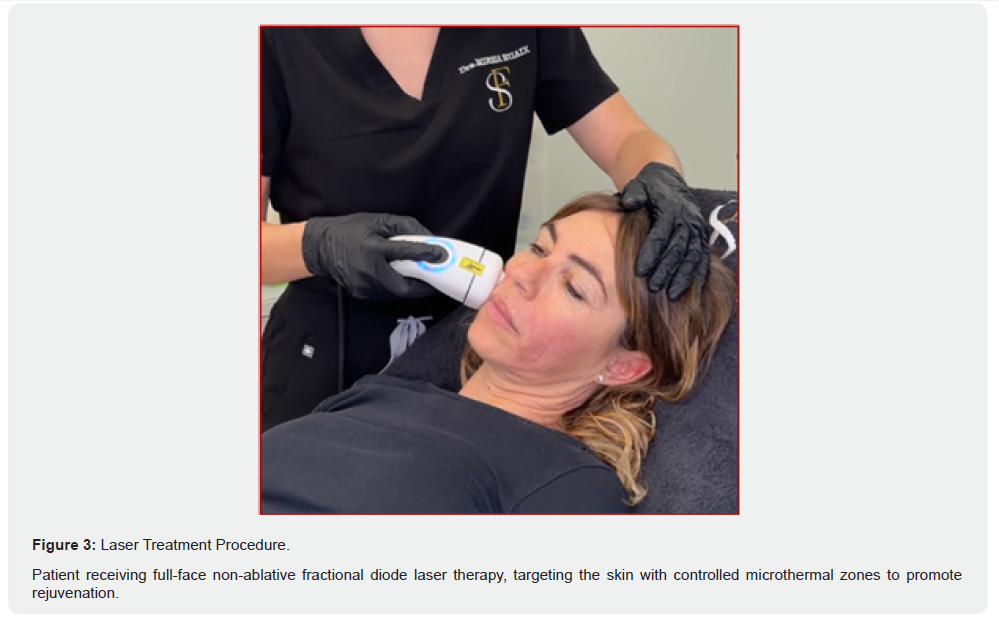
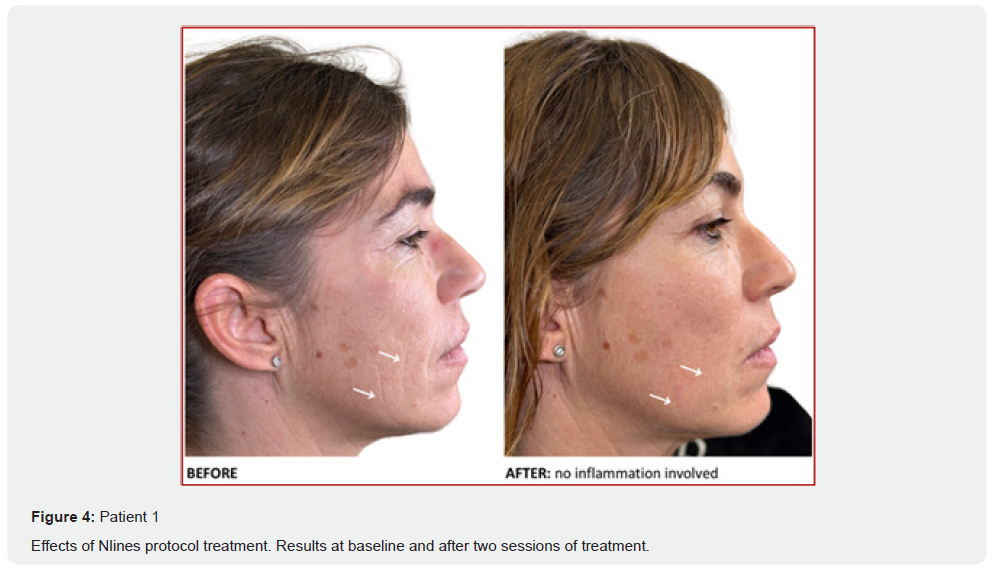
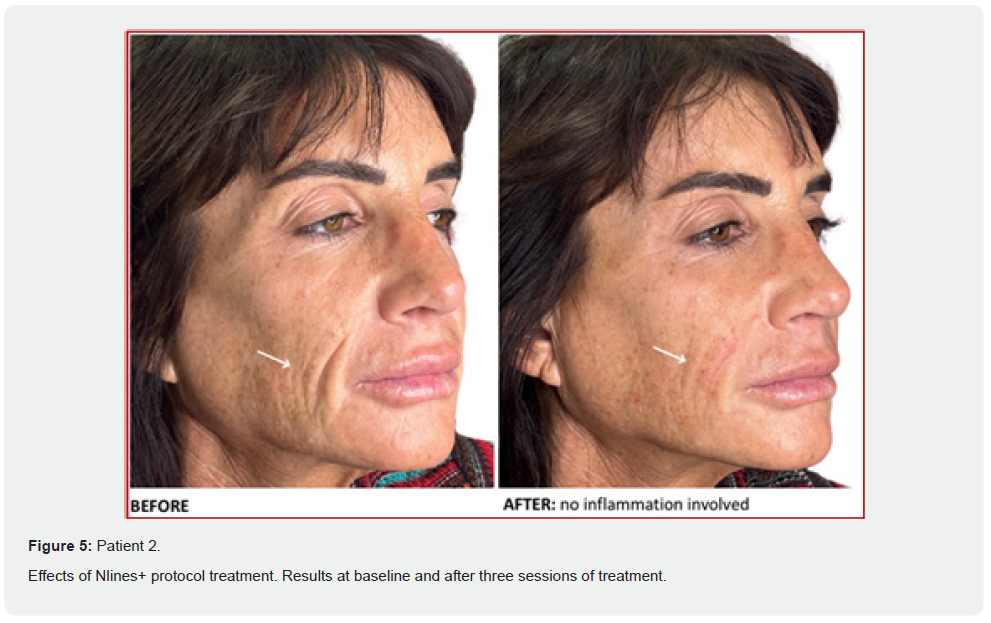

Both patients experienced only mild redness, lasting a few hours, with no other adverse effects. Interestingly, they independently described an immediate ‘glow’ after treatment. In the following weeks, they perceived a natural rejuvenation, as acquaintances often commented that they looked more attractive or refreshed without identifying the reason. The most noticeable improvements included firmer, thicker, and lifted skin, decreased elastosis, and a clear reduction in static fine lines/wrinkles in the treated areas, resulting in an overall fresher, more radiant complexion.
This case study aimed to evaluate the aesthetic impact of combining cross-linked hyaluronic acid (PEGDE-HA) injections with non-ablative fractional laser therapy. The results support the potential effectiveness of this combined approach; however, the main limitations were the small sample size and the lack of standardized patient satisfaction measures such as FACE-Q or GAIS. Future research should include larger cohorts, validated assessment tools, and methodological standardization to confirm these findings and better capture both subjective experiences and objective clinical outcomes.
Discussion
The present case study demonstrates that the Nlines protocol, combining PEGDE-crosslinked hyaluronic acid (HA) filler with a non-ablative fractional 1470 nm diode laser, produces measurable and visible improvements in skin quality, including reduction of fine lines, pore size refinement, and enhanced dermal firmness. These outcomes align with the growing body of evidence supporting multimodal approaches for facial rejuvenation, which address both structural and textural components of skin aging.
Aging in the perioral and lower facial regions is multifactorial, involving dermal thinning, loss of subcutaneous volume, reduced collagen and elastin content, and cumulative photodamage [5]. Monotherapy-whether injectable or device-based often fails to address these changes comprehensively. Combining fillers with energy-based devices has been shown to produce synergistic effects: fillers restore lost volume and provide mechanical support, while lasers stimulate neocollagenesis, elastogenesis, and dermal remodeling [10,11,20].
PEGDE-based crosslinking technology offers specific advantages for combination protocols. PEGDE exhibits lower cytotoxicity and immunogenicity, while maintaining high cohesivity and viscoelasticity [13]. Its thermal tolerance also permits safe sequential use with laser treatments without degradation of the gel [15]. This makes it particularly suited for protocols like Nlines, where injectable and laser therapies are performed in the same session. The immediate post-procedure changes-described by patients as instant radiance-may result from a combination of dermal hydration from HA, transient erythema increasing microcirculation, and optical scattering changes in the skin [21].
Over subsequent weeks, non-ablative fractional laser treatment creates microscopic thermal zones in the dermis, initiating a wound-healing cascade that increases collagen types I and III, as well as elastin fibers [17,19,22,23]. Concurrently, the filler maintains structural support, minimizing wrinkle reformation during collagen remodeling [24,25]. The addition of glycine and L-proline-key amino acids involved in collagen synthesis - further amplifies the skin-rejuvenating effects of the treatment [26-28.] This synergy could explain the sustained improvement in texture, firmness, and skin tone observed in our patients. Comparable results have been reported in studies combining HA with non-ablative erbium glass or diode lasers, which showed superior patient satisfaction compared to either modality alone [10,11].
Both patients in this study tolerated the Nlines protocol well, reporting only transient erythema that was resolved within hours. This is consistent with prior findings indicating that combining HA fillers with fractional non-ablative lasers is safe when proper energy settings and injection techniques are used [10,11]. PEGDE- HA’s favorable safety profile likely contributes to this outcome [16,24,29]. The observed benefits in patients of different ages and Fitzpatrick skin types suggest that the Nlines protocol may be applicable across a broad patient population. Nevertheless, caution should be exercised in individuals with active infections, impaired wound healing, or unrealistic expectations. Furthermore, tailoring filler placement and laser parameters to the patient’s degree of volume loss, skin laxity, and pigmentation risk is essential for optimal results [19].
The main limitations of this work include the small sample size, the lack of objective quantitative skin assessments (e.g., 3D skin imaging, corneometry), and the absence of validated patient- reported outcome measures such as the Global Aesthetic Improvement Scale (GAIS) or FACE-Q [30,31]. While our photographic assessments provide qualitative evidence, future studies should include standardized measurement tools and larger, more diverse cohorts to strengthen external validity. Additionally, histological analysis could help confirm the regenerative effects hypothesized in this protocol. Overall, the Nlines protocol appears to be a safe, well-tolerated, and minimally invasive approach to perioral and lower face rejuvenation. By combining structural restoration with dermal bio-stimulation, it reduces fine lines and wrinkles, improves skin texture, and enhances firmness, delivering both immediate and progressive regenerative benefits.
- Horn S, Matuszewska N, Gkantidis N, Verna C, Kanavakis G (2021) Smile dimensions affect self-perceived smile attractiveness. Sci Rep 11(1): 2779.
- Kościński K (2007) Facial attractiveness: General patterns of facial preferences. Anthropol Rev 70: 45-79.
- Thompson LA, Malmberg J, Goodell NK, Boring RL (2004) The Distribution of Attention Across a Talker’s Face. Discourse Process 38(1): 145-168.
- Samuels CA, Butterworth G, Roberts T, Graupner L, Hole G (1994) Facial Aesthetics: Babies Prefer Attractiveness to Symmetry. Perception 23(7): 823-831.
- Serna EM, Benbassat MS, Falcón RT, Martín JM (2021) Anatomy and Aging of the Perioral Region. Facial Plast Surg 37(2): 176-193.
- Uwe Wollina (2013) Perioral rejuvenation: restoration of attractiveness in aging females by minimally invasive procedures. Clin Interv Aging 8: 1149-1155.
- Mohammad Ali Nilforoushzadeh, Maryam Heidari-Kharaji, Tannaz Fakhim, Seyedeh Tina Hosseini, Shohreh Rafiee, et al. (2023) Efficacy evaluation of endolift laser for treatment of nasolabial folds and marionette lines. Skin Res Technol 29(10): e13480.
- Ma X, Li F (2022) Autologous fat grafting for perioral and lower face rejuvenation]. Zhongguo Xiu Fu Chong Jian Wai Ke Za Zhi Zhongguo Xiufu Chongjian Waike Zazhi Chin J Reparative Reconstr Surg 36(12): 1542-1548.
- Park KY, Kim HK, Kim BJ (2014) Comparative study of hyaluronic acid fillers by in vitro and in vivo testing. J Eur Acad Dermatol Venereol 28(5): 565-568.
- Akerman L, Mimouni D, Nosrati A, Hilewitz D, Solomon-Cohen E (2022) A Combination of Non-ablative Laser and Hyaluronic Acid Injectable for Postacne Scars: A Novel Treatment Protocol. J Clin Aesthetic Dermatol 15(3): 53-56.
- Kroeskop A, Voropai D (2025) A combination treatment protocol using PEGylated hyaluronic acid hydrogel, non-ablative laser and hyaluronic acid skin boosters for rejuvenation of the perioral area. J Appl Cosmetol 43(1).
- Khunmanee S, Jeong Y, Park H (2017) Crosslinking method of hyaluronic-based hydrogel for biomedical applications. J Tissue Eng 8: 2041731417726464.
- Do Hyun Kim, Chang Hee Jeong, Jong Hyeon Han, Su Jin Lim, Hyuk Cheol Kwon, Yea Ji Kim, et al. (2025) Comparative toxicity study of hyaluronic acid fillers crosslinked with 1,4-butanediol diglycidyl ether or poly (ethylene glycol) diglycidyl ether. Int J Biol Macromol 296: 139620.
- Jurairattanaporn N, Amornpetkul W, Rutnin S, Vachiramon V (2023) The effect of combined hyaluronic acid filler injection and radiofrequency treatment: A clinic histological analysis. J Cosmet Dermatol 22(3): 798-803.
- Kubik P, Gruszczyński W (2023) Heat Influence on Different Hyaluronic Acid Fillers. J Appl Cosmetol 41(2).
- N Zerbinati, E D'Este, A Farina, R Rauso , M Cherubino, A Calligaro (2017) Morphological evidences following pegylated filler treatment in human skin 31(2 Suppl. 2): 79-85.
- Manstein D, Herron GS, Sink RK, Tanner H, Anderson RR (2004) Fractional Photothermolysis: A New Concept for Cutaneous Remodeling Using Microscopic Patterns of Thermal Injury. Lasers Surg Med 34(5): 426-438.
- Alexiades-Armenakas MR, Dover JS, Arndt KA (2008) The spectrum of laser skin resurfacing: Nonablative, fractional, and ablative laser resurfacing. J Am Acad Dermatol 58(5): 719-737.
- Assessment of Safety and Mechanisms of Action of the 1470 nm LaserMe Device. Gen Med.
- Abdelwahab AA, Omar GA badea, Hamdino M (2023) A combined subcision approach with either fractional CO2 laser (10,600 nm) or cross-linked hyaluronic acid versus subcision alone in atrophic post-acne scar treatment. Lasers Med Sci 38(1):20.
- Ramazanova I, Kurbankadieva B (2025) Case Study on a Multi-Layer Approach to Skin Rejuvenation: Effects of Energy-Based Devices and Injectable Biostimulatory Therapies 43(2).
- Liu H, Dang Y, Jiang L, Wang Z, Ren Q (2006) Non-ablative collagen remodeling initiated by two different laser effects: comparative study on mouse model. In: 2006 International Symposium on Biophotonics, Nanophotonics and Metamaterials. IEEE 2006: 80-83.
- Leheta T, El Garem Y, Hegazy R, Abdel Hay RM, Abdel Halim D (2013) Non-ablative 1540 fractional laser: How far could it help injection lipolysis and dermal fillers in lower-face rejuvenation? a randomized controlled trial. J Cosmet Laser Ther 15(1): 13-20.
- Rauso R, Nicoletti GF, Bove P, Giuseppe M Rauso, Romolo Fragola et al. (2021) Clinical Experience with PEGylated Hyaluronic Acid Fillers: A 3-year Retrospective Study. Open Access Maced J Med Sci 9(B): 1168-1173.
- Suryadevara AC (2008) Update on perioral cosmetic enhancement. Curr Opin Otolaryngol Head Neck Surg 16(4): 347-351.
- Karna E, Szoka L, Huynh TYL, Palka JA (2019) Proline-dependent regulation of collagen metabolism. Cell Mol Life Sci CMLS 77(10): 1911-1918.
- Kay EJ, Koulouras G, Zanivan S (2021) Regulation of Extracellular Matrix Production in Activated Fibroblasts: Roles of Amino Acid Metabolism in Collagen Synthesis. Front Oncol 11: :719922.
- Antonio Scarano, E Qorri, A Sbarbati, SA Gehrke, Alessio Frisone, et al. (2024) The efficacy of hyaluronic acid fragments with amino acid in combating facial skin aging: an ultrasound and histological study. J Ultrasound. 2024;27(3): 689-697.
- Paweł Kubik, Daniela Gallo, Maria Laura Tanda, Jerzy Jankau, Raffaele Rauso, et al. (2023) Evaluation of the Safety of Neauvia Stimulate Injectable Product in Patients with Autoimmune Thyroid Diseases Based on Histopathological Examinations and Retrospective Analysis of Medical Records. Gels 9(6): 440.
- Klassen A, Cano S, Scott A, Snell L, Pusic A (2010) Measuring Patient-Reported Outcomes in Facial Aesthetic Patients: Development of the FACE-Q. Facial Plast Surg 26(04): 303-309.
- Jain R, Huang P, Ferraz RM (2017) A new tool to improve delivery of patient-engaged care and satisfaction in facial treatments: the Aesthetic Global Ranking Scale. J Cosmet Dermatol 16(1): 132-143.






























